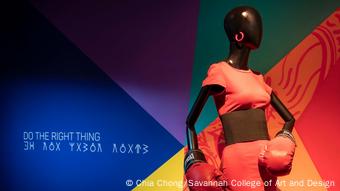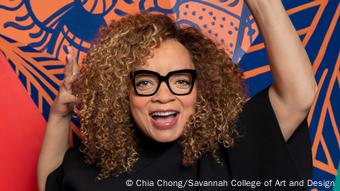Afrofuturism in Hollywood: Costumes by Ruth E. Carter | Culture | DW
It is the most commercially successful American Afro-futuristic work to date: the Marvel blockbuster “Black Panther” was nominated for an Oscar in seven categories in 2019 and ultimately won three Oscars, including Best Picture and Best Costume.
Ruth E. Carter was responsible for the fashionable designs. The designer, who was born on April 10, 1960 in Springfield, Massachusetts, had actually planned a completely different career: She wanted to be an actress. But when she was helping out in the costume department of the student theater company at Hampton University, she found a new calling.
After graduating from university, she trained as a costume designer at the Santa Fe Opera in New Mexico and then moved to the film metropolis of Los Angeles. Ruth E. Carter has been designing costumes for American independent films and Hollywood blockbusters for more than forty years. The 61-year-old has worked with Stephen Spielberg, Denzel Washington and Samuel L. Jackson and won an Oscar for her groundbreaking costumes in the Marvel blockbuster “Black Panther” (2018).
Fashion conveys a new image of Africa
The Marvel world success “Black Panther” also lives from the decoration of the protagonists, whose robes can be seen in an exhibition at the SCAD Museum Fashion + Film in Atlanta (USA) until September 2021. After months of research into African fashion and with new 3D technology, Carter invented his own style: colorful, majestic, technologically advanced. Carter purposefully designed Afro-futuristic costumes. For her, as she puts it in the exhibition catalog, Afrofuturism means: “To combine technology with imagination and self-expression in order to advance a philosophy for black Americans, Africans and indigenous people that allows them to believe and create without the barriers of Slavery and colonialism. “

Ruth E. Carter has been working as a costume designer in Hollywood for 40 years. As early as 1989 she designed the costumes for Spike Lee’s film “Do the Right Thing”.
This utopian trend in Afrofuturism is still relatively young, explains Natalie Zacek, lecturer in American history and culture at the University of Manchester, in an interview with DW. There are many different definitions of Afrofuturism, the phenomenon has been around for 25 years. It conveys a new picture of African history: “Lately in particular, Afrofuturism has often been about imagining a world in which there was no transatlantic slave trade, no European colonization of the African continent Have become societies, ask the artists “, says Zacek.
Afrofuturism from Africa looks different
The visions of the future from the United States are different from those from the African continent. African authors have been writing science fiction for decades, most of which are classically set in space or in the futuristic big city. In recent years the topic of the climate crisis has also been added. The “African Speculative Fiction Society” regularly awards the Nommo Awards for the best novel, the best novel, the best short story and the best graphic novel in this genre. “For artists in the USA and Great Britain, the experience of the diaspora is in the foreground because of the slave trade,” explains Natalie Zacek. As the place of the ancestors, Africa is an almost mythically charged place in the past. It is different for African artists who live in Ghana or Nigeria, for example. “There, in science fiction, three things are in the foreground: the city, space and the future.”
African filmmakers also dare to try science fiction, such as Dilman Dila or Jean-Pierre Bekolo. Often they can only dream of the budget of a Hollywood production. “The only film funding an African filmmaker can get comes from Europe, and European producers usually select material that they think will be well received at film festivals that deal with supposedly African topics such as AIDS and genocide , the climate crisis and famine, “wrote author and filmmaker Dilman Dila in 2017 in the international science fiction and fantasy magazine” Mithila Review “when his science fiction film” Her Broken Shadow “appeared, which aesthetically looked closer to” Blade Runner ” reminiscent of “Black Panther”. Commercial, even entertaining material would have a hard time, Dila said there was no way of financing expensive special effects.
Carter wants to provide a new perspective on Africa
Not so in Hollywood: The US film “Black Panther” presents a utopia that is bursting with entertainment value, special effects and visually impressive costumes. The film is set in the fictional Wakanda, an African nation that is technologically much more advanced than any other state in the world because it has never experienced slavery and colonialism, and it looks very good doing it. “That’s what makes Black Panther so attractive,” says Zacek.

The costume designer Ruth E. Carter poses in December 2020 in the exhibition room of the SCAD FASH Museum of Fashion + Film.
This is also reflected in Carter’s costumes, in which Zacek primarily recognizes influences from South and West Africa. The costumes combined African fashion traditions with ultra-modern technology, according to Zacek. You don’t even have to have seen the film, she explains that the combination of technology and African-looking fashion alone creates an Afro-futuristic message.
In contrast to the films by African directors such as Dilman Dila or Jean-Pierre Bekolo, “Black Panther” with Ruth E. Carter’s costume design developed into a worldwide success – and at least it proved to Hollywood that a film in which hardly any white actors appear is the box office can ring the bell. And Ruth E. Carter was the first African American woman to win an Oscar.

These costumes from the movie “Selma” reflect the fashion in the USA of the 1960s.
According to Zazek, there is no exchange with the Francophone or African-speaking cultures of Africa in English-speaking Afrofuturism. In her career as a costume designer, Ruth E. Carter has also mainly dealt with the Afro-American experience, as the exhibition in Atlanta makes clear, in which 60 drafts of her costumes can be seen. Stephen Spielberg commissioned her to design costumes for American slaves and slave owners in the 19th century. Spike Lee had her dress an Afro-American action hero, and even the civil rights icon Martin Luther King in “Selma”. For “Black Panther”, according to the exhibition catalog, she had decided to prescribe a radical change of perspective for the American audience: “I think people will now be able to contextualize and appreciate African art in a completely different way. That’s what we did: We have it estimated, we rethought it, we refined it and moved it to another place. “




